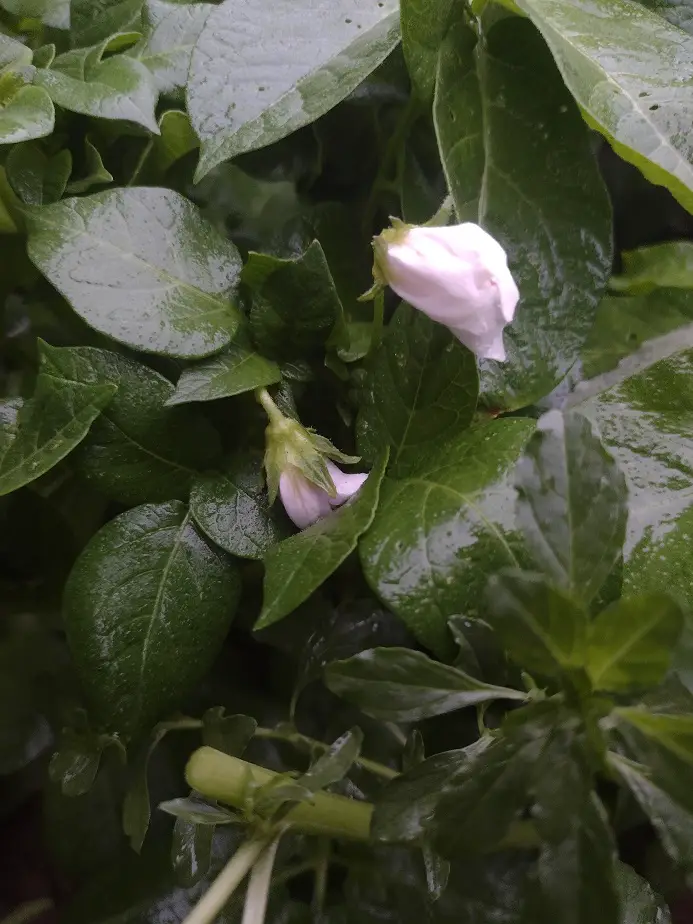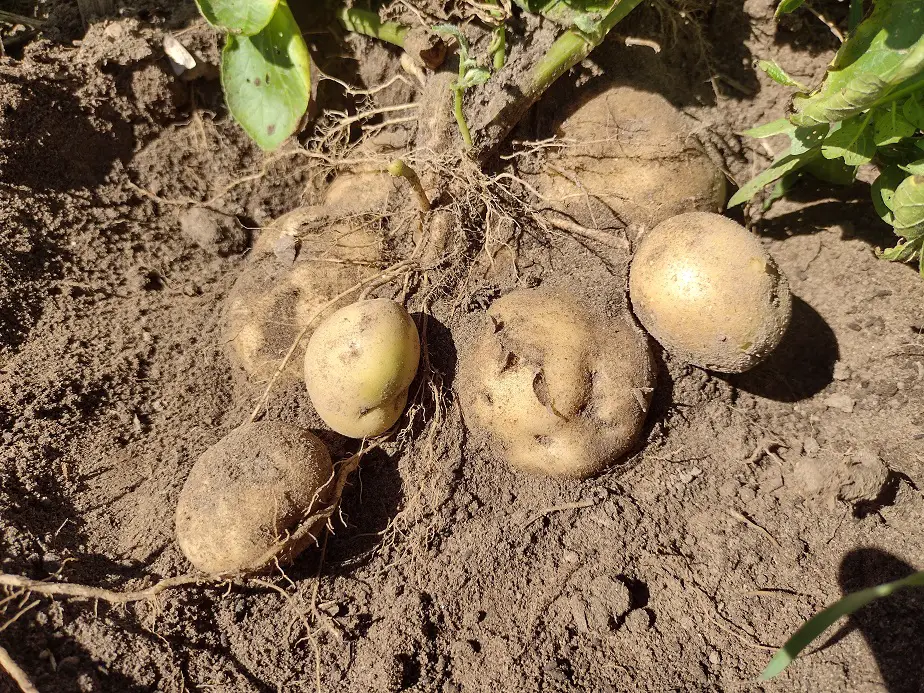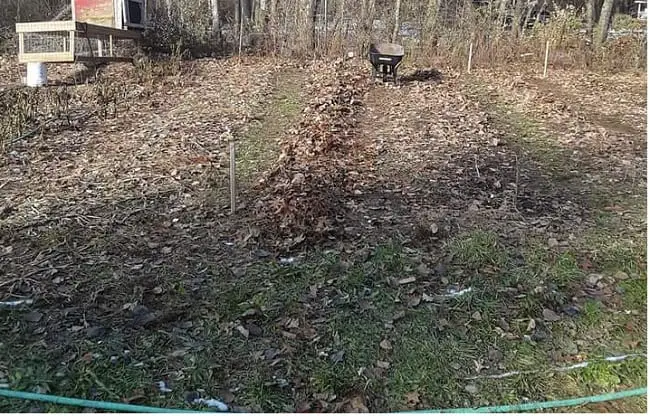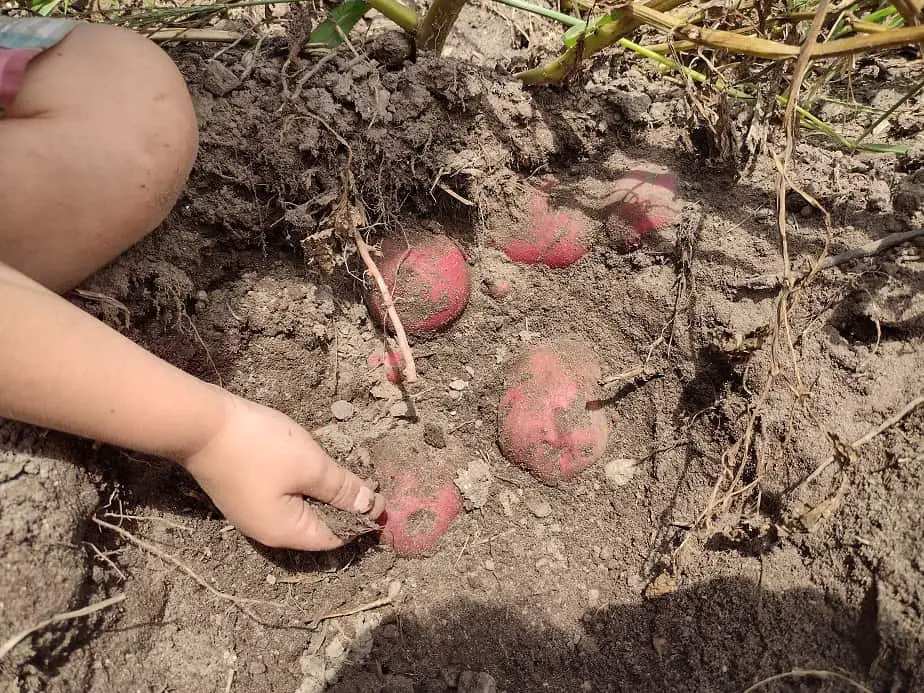Here’s why I’m convinced potatoes are one of the best crops to grow.
Potatoes can be Panted Before Other Crops
Potatoes can be planted months before crops like beans and tomatoes. You can get done with planting potatoes well before there are any other garden chores to worry about. By planting early, you actually have time later to keep up with the weeds, and with all the other crops in the garden.
I plant potatoes between March and May but can plant much else until almost June for fear of frost. Young potatoes can take a frost just fine. If I cover them with 6-inches of straw, I can plant potatoes at least 2 months before the last frost date, and they’ll be knee-high by June.
PLanting early also gives them a huge headstart against the weeds. there will be a lot fewer weeds sprouting because the potato plants overshade the soil so well.
They Don’t Need Pollination
Potatoes don’t care about pollination. Even in small gardens with few pollinators, potatoes will do just fine. I’ve grown a 50×50 foot patch of corn that pollinated very poorly, resulting in a very poor yield. I’ve had pumpkins that didn’t grow because the winter killed off local bee hives. The potatoes still did great.
Insects may not come around at the right time or the wind might not do its pollinating work. If you happen to get bad seeds or you plant them at uneven depths, other crops may not pollinate well and you’ll have a poor harvest. But potatoes will do just fine.

They can be Harvested Early
Potatoes can be harvested early and still be very good potatoes. Sometimes called new potatoes, early harvested potatoes are ready to wash and cook. They are very soft and tender. Early-harvested potatoes are harvested at least a month early and fetch a premium market price.
Potatoes can be harvested as early as June. In many areas, you can fall plant potatoes, overwinter them, and get a late-spring harvest. Early-spring planted potatoes are ready for harvest one to two months before the main harvest season.
Potatoes Have High Yields
Potatoes can harvest 3-6 pounds per plant, depending on the variety. A 10-foot row can yield up to 60 pounds of mature potatoes. That’s more food than any other high-calorie crop. A single potato plant can produce over 2,000 calories.
Potatoes are planted a foot apart, which maximizes garden space. A 100-foot row holds 100 plants. That’s enough for a hefty family-sized serving every day for three months. There’s a reason so many early settlers grew and lived off potatoes.
They can be Harvested a Month After Maturing
Potatoes don’t have to be harvested at a certain time. They won’t get overripe or go bad if you don’t get to them for a while. Potatoes can actually be harvested a month early or a month late without trouble. They’re still edible potatoes. In fact, potatoes can be left in the ground until just before a hard freeze.
That’s what I love best about potatoes. I get very busy around harvest time. I’ll often leave the potatoes until there’s not much else going on. They can mature in the summer and stay in the dirt through fall with minimal loss. I may see a few with bug damage, but that’s all.

Potatoes are More Productive than Other Crops
Potatoes can grow more food per square foot than any other field crop, in terms of calories and nutrition. Corn, wheat, beans, and pumpkins, none produce quite as much food value per square foot as potatoes. I’ve tried sugar beets, mangels, giant corn varieties, potatoes outproduce them all.
In order to be productive, they need enough rainfall or irrigation. Many areas can’t grow good crops of potatoes, or anything really, without some kind of basic irrigation. I wrote an article on watering potatoes. Here’s a link to it.
Potatoes can Overwinter in the Ground
Potatoes can actually be stored through winter right in the soil. As long as the dirt doesn’t freeze solid, it’s basically a storage compartment for spuds. It’s a viable technique as far north as USDA Zone 4. It can take some work in the colder areas. Especially those with little snowfall.
By covering potato beds with fallen leaves or straw, I can actually keep potatoes in the soil and prevent them from freezing all winter long. But, if the soil isn’t well-drained, it may cause some to rot. This is quite similar to using a traditional root cellar.
Another traditional way to store potatoes is to be stored through winter by heaping them in deep piles in a barn, then covering them with a deep layer of straw. The natural heat of the ground, around 45 degrees, keeps them from freezing if they are insulated well. But, that’s not really for areas colder than Zone 5.

Potatoes can be Planted in The Fall
Fall-planted potatoes, also known as the Irish method, Can be easily overwintered and will begin growing very rarely in the spring. Planting this way can give you a harvest two months earlier than normal, by June. There may be up to a 20 percent loss from freezing and waterlogged spring soil, but still a decent harvest.
Here in USDA Zone 5b, 10 inches deep of straw or mulched leaves under the snow will keep even the worst freeze out. I can plant them as late as November, or even December if the ground hasn’t frozen.
Potatoes Tolerate Very Acidic Soil
Potatoes can grow in soil that little else will. Sandy, acidic soils with a pH of 4.8, which is to acidic for even grass to grow well. Although, soil with a pH of 6-6.5 is considered Ideal. Personally, m garden soil is about 6.8 or 6.9, and potatoes seem to love it.
Potatoes Store Well
Potatoes can be dug up and stored, just like that. In fact, the less they have handled the better they store. potatoes store best without refrigeration, just sitting on a shelf in a dark pantry. They don’t store as well as dry corn or other grains, but they also don’t have to be dried out first.
I lost over half of my corn harvest last year because we had heavy rains, making it very humid. I couldn’t dry the corn out fast enough, even inside. Half of it went moldy. So, Potatoes potatoes potatoes.
Related Articles:

